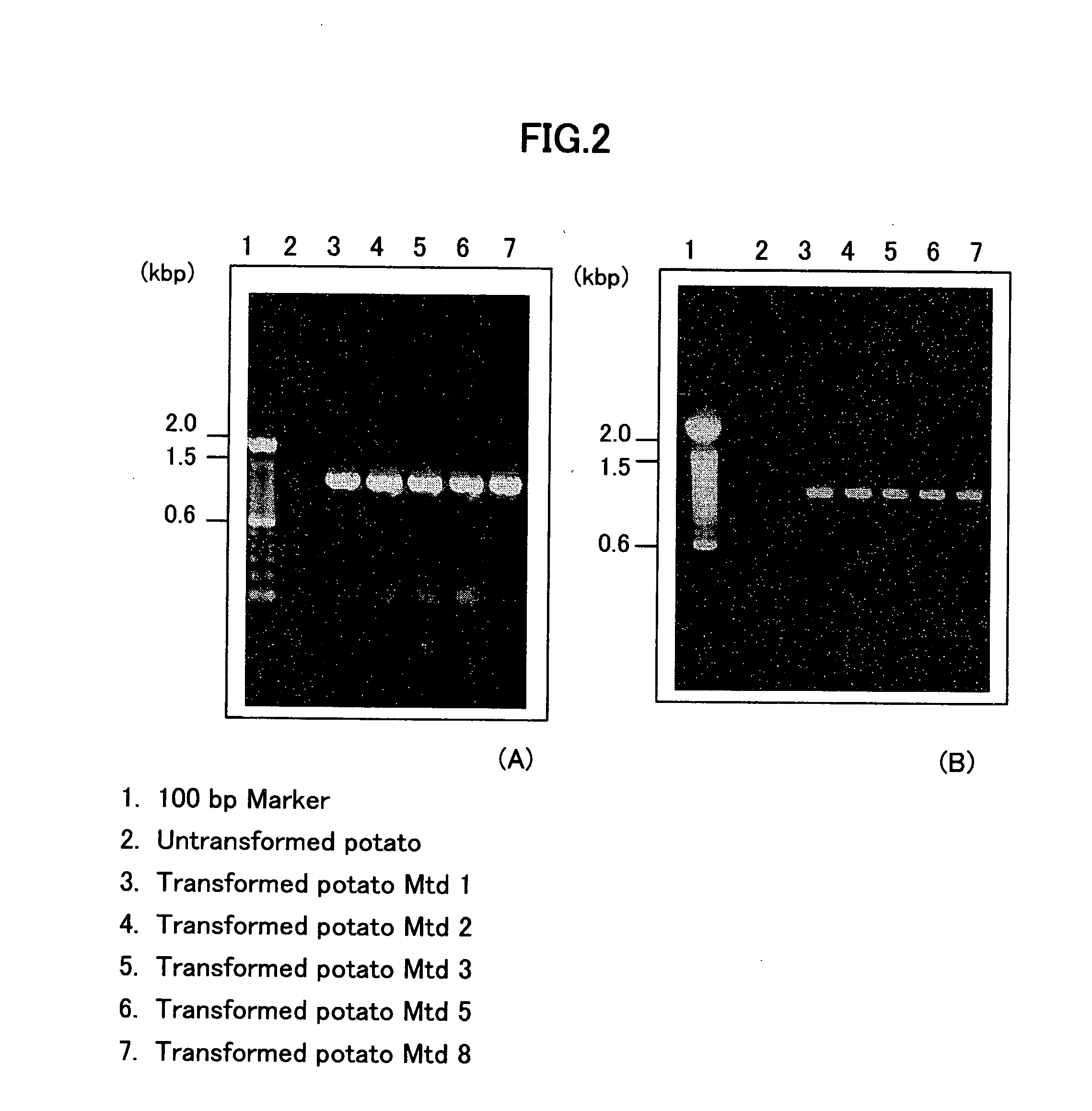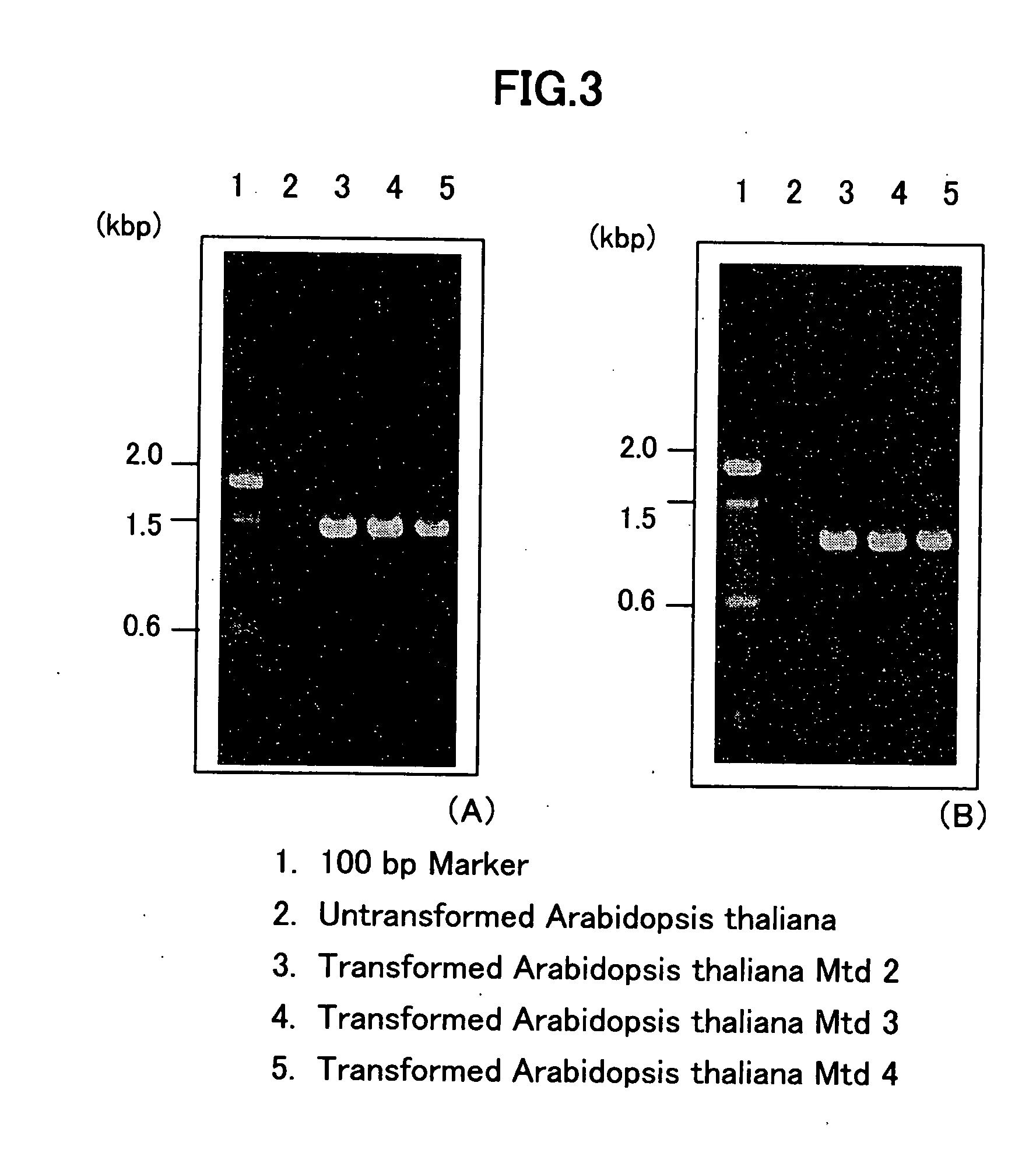Methods for producing plants with improved growth under nitrogen-limited conditions
a technology of nitrogen-limited conditions and plants, applied in the direction of plant genotype modification, fermentation, biochemistry apparatus and processes, etc., can solve the problems of reducing the growth rate of plants, and reducing the yield of plants, so as to improve the growth and/or yield
- Summary
- Abstract
- Description
- Claims
- Application Information
AI Technical Summary
Benefits of technology
Problems solved by technology
Method used
Image
Examples
example 1
Isolation of Aspergillus nidulans-Derived NADP-Dependent GDH Gene, and Construction of Ti Plasmid Vector
[0066] (1) Isolation of Aspergillus nidulans-Derived NADP-Dependent GDH Gene
[0067]A. nidulans was seeded on potato dextrose agar medium and cultured overnight at 30° C., and the resulting colony was cultured for 2 days in liquid dextrose medium. Total RNA was prepared from the proliferated cells.
[0068] mRNA was purified using a Poly(A) Quick mRNA Isolation Kit (Stratagene), and First-strand cDNA was prepared using a First-strand cDNA Synthesis Kit (Amersham Bioscience). A PCR reaction was performed using the prepared First-strand cDNA as the template. The PCR reaction conditions were 35 cycles of 3 minutes at 94° C., 45 seconds at 94° C., 30 seconds at 59° C. and 90 seconds at 72° C., followed by 10 minutes at 72° C., using a Perkin-Elmer PCR system 2400. The primers used were 5′-TCT AGA ATG TCT AAC CCC CTT GTT GAG-3′ (SEQ ID NO: 5) and 5′-GAG CTC TCA CCA CCA GTC ACC CTG GTC-3′...
example 2
Development of Potato Transformant
[0071] Potatoes (May Queen cultivar) were transformed according to the methods of Gordon et al (Ref: Plant Cell Reports, 1993, 12:324-327). Sterilely-induced microtubers were cut, and tuber discs were prepared, placed on MS agar medium supplemented with 2 mg / l zeatin and 0.1 mg / l indole, and cultured for 24 hours at 25° C. with a 16 hour day length. Agrobacterium comprising the constructed gene was inoculated on YEP medium (10 g / l Bacto Tryptone, 10 g / l yeast extract, 1 g / l glucose) containing 50 mg / l kanamycin and 50 mg / l hygromycin, and shaking cultured overnight at 28° C. The Agrobacterium culture was added to infect the tuber discs that had been cultured for 24 hours. After 10 minutes, the excess Agrobacterium was removed using sterilized filter paper, transferred to the aforementioned dish, and cultured for 24 hours under the same conditions. The tuber discs were then transferred on MS agar medium containing 50 mg / l kanamycin, 300 mg / l cefotax...
example 3
Production of Arabidopsis thaliana Transformants
[0072] Gene introduction into Arabidopsis thaliana was accomplished according to the methods of Bechtold et al (Ref: C. R. Acad. Sci. Paris, Life Science 316:1194-1199, 1993). Arabidopsis thaliana seeds were planted on culture soil, and after 10 days of cultivation at 24° C. with a 16 hour day length, the seedlings were transplanted one by one to individual pieces of rock wool, and cultivated for two more weeks under the same conditions. The plants were pinched as soon as they began to bolt, and were then cultivated for another week. Agrobacterium was shaking cultured for 24 hours at 28° C. in YEP culture containing 50 mg / l kanamycin and 50 mg / l hygromycin, and cells were collected by centrifugation (7,000 rpm, 10 minutes). The cells were suspended in suspension medium for infiltration (½ MS salts, ½ B5 vitamin, 5% sucrose, 0.5 g / l MES, 0.044 μM benzylaminopurine, pH 5.7). After removal of the flowering organs which had already flower...
PUM
| Property | Measurement | Unit |
|---|---|---|
| Mass | aaaaa | aaaaa |
| Weight | aaaaa | aaaaa |
| Weight | aaaaa | aaaaa |
Abstract
Description
Claims
Application Information
 Login to View More
Login to View More - R&D
- Intellectual Property
- Life Sciences
- Materials
- Tech Scout
- Unparalleled Data Quality
- Higher Quality Content
- 60% Fewer Hallucinations
Browse by: Latest US Patents, China's latest patents, Technical Efficacy Thesaurus, Application Domain, Technology Topic, Popular Technical Reports.
© 2025 PatSnap. All rights reserved.Legal|Privacy policy|Modern Slavery Act Transparency Statement|Sitemap|About US| Contact US: help@patsnap.com



